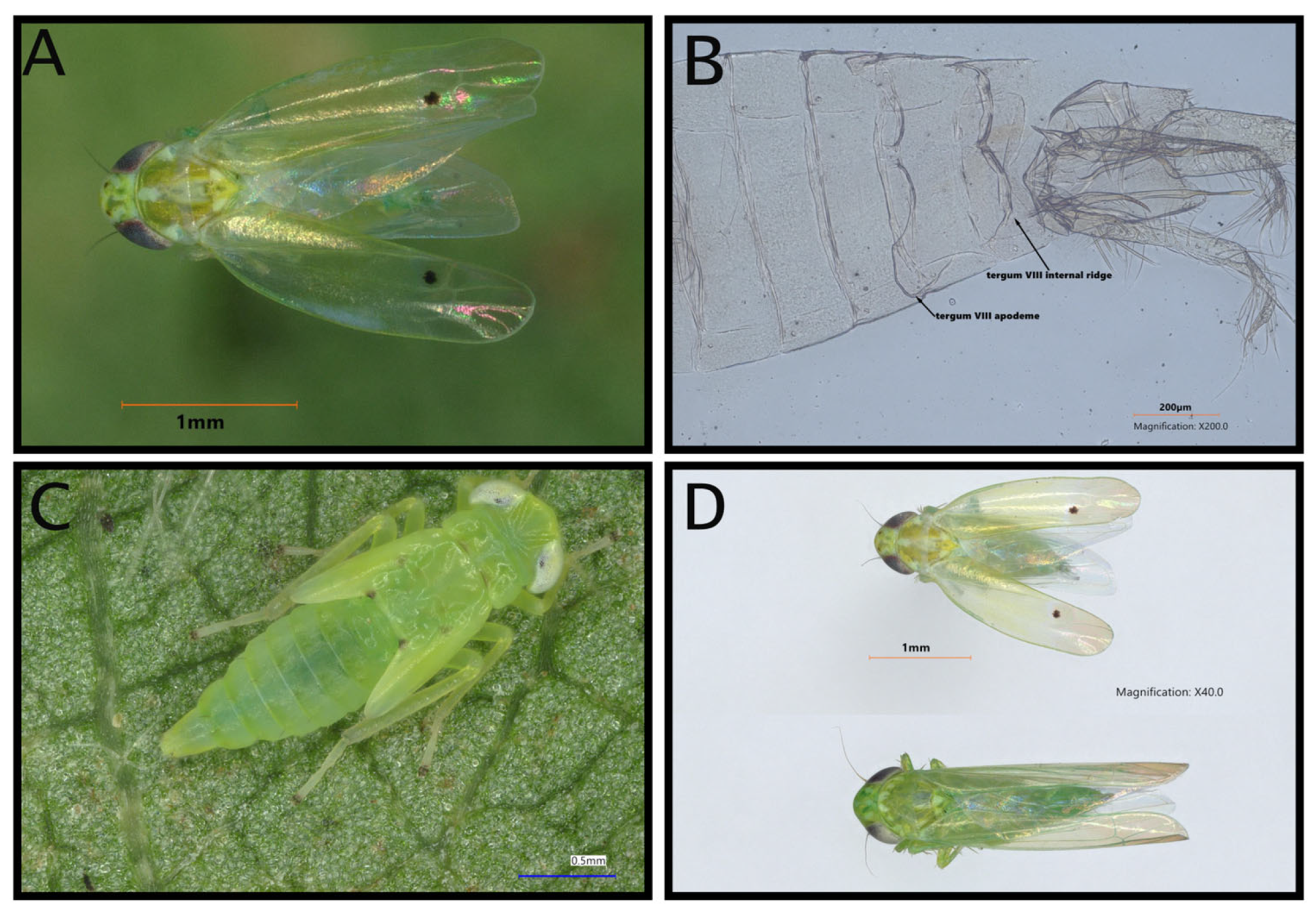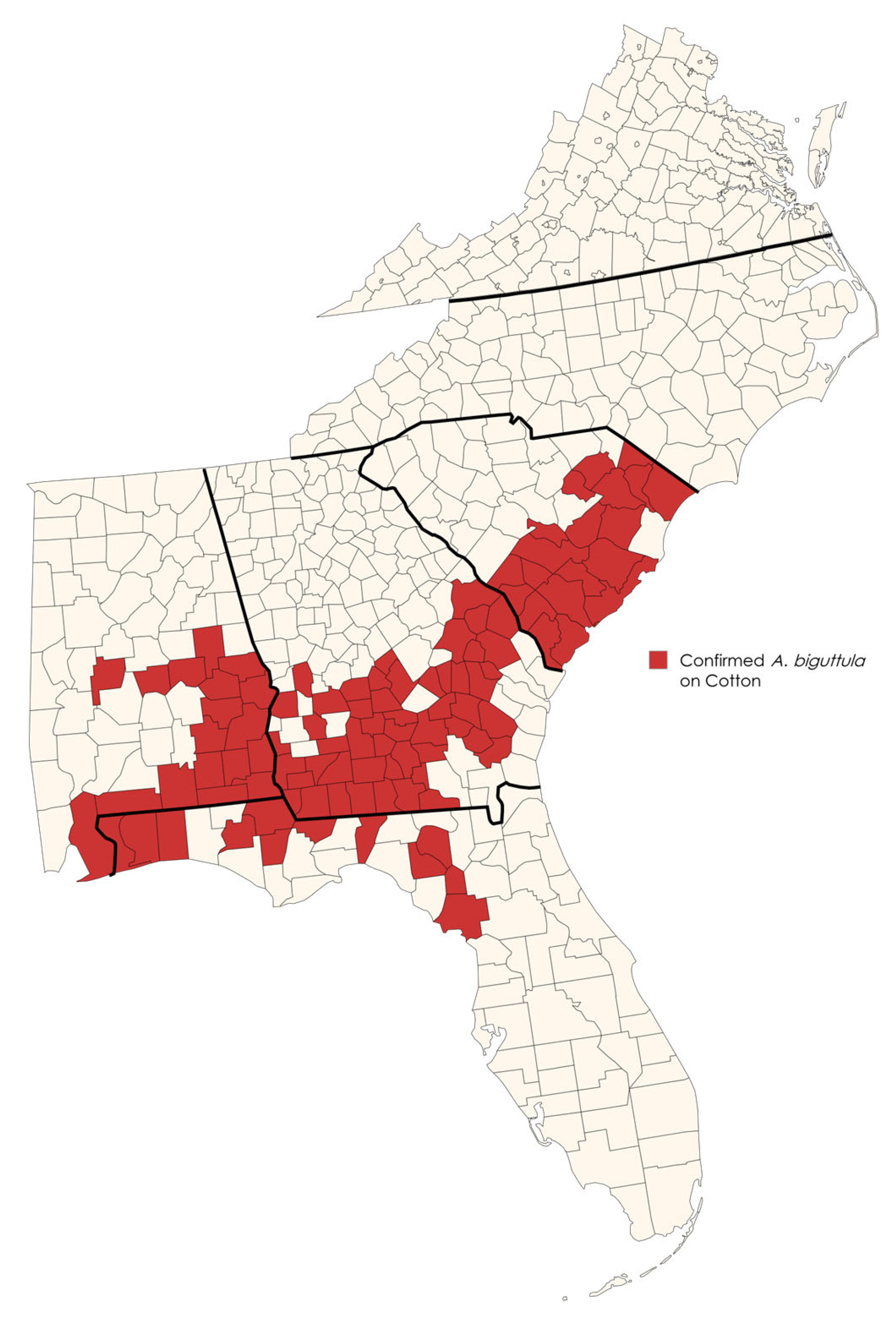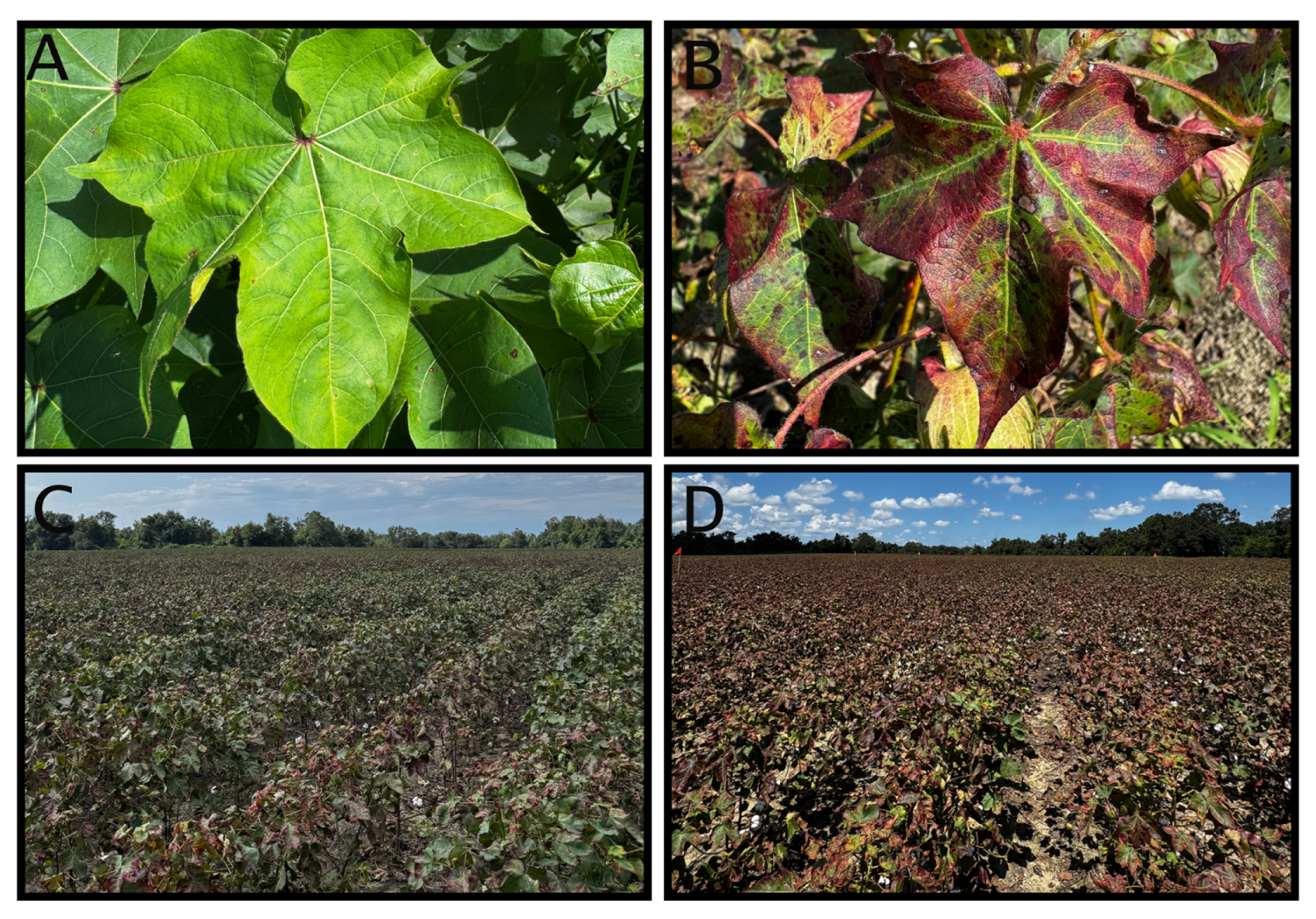First Report of Two-Spot Cotton Leafhopper (Amrasca biguttula Ishida) (Hemiptera: Cicadellidae) on Commercial Cotton in the Southeastern United States
Simple Summary
Abstract
1. Introduction
2. Materials and Methods
Survey and Collection of Amrasca biguttula
3. Results
Survey, Collection, and Identification of Amrasca biguttula
4. Discussion
5. Conclusions
Author Contributions
Funding
Data Availability Statement
Acknowledgments
Conflicts of Interest
References
- CABI Digital Library. Amrasca biguttula biguttula (Indian Cotton Jassid). Available online: https://doi.org/10.1079/pwkb.species.20857 (accessed on 1 August 2025).
- Rajendran, T.P.; Birah, A.; Burange, P. Insect Pests of Cotton. In Pests and Their Management; Springer: Berlin/Heidelberg, Germany, 2018; pp. 361–411. ISBN 978-981-10-8686-1. [Google Scholar]
- Thapa, R.; Bista, K.; Bhatta, M.; Bhandari, S.; Acharya, R.; Sapkota, B. Comparative Performance and Economic Efficiency of Different Pesticides against Okra Jassids (Amrasca biguttula biguttula): Their Impact on Okra Yield and Growth Attributes. J. Entomol. Zool. Stud. 2019, 7, 525–531. [Google Scholar]
- Ahmad, Z.; Attique, M.R.; Rashid, A. An Estimate of the Loss in Cotton Yield in Pakistan Attributable to the Jassid Amrasca devastans Dist. Crop Prot. 1986, 5, 105–108. [Google Scholar] [CrossRef]
- Jacques, H.D.; Socrates, D.N.; Bouladji, Y.; Djague, T.L.; Moïse, A.; Noé, W. First Infestation of an Exotic Crops Pest, Amrasca biguttula on Cotton Gossypium hirsutum L. in North Cameroon. Int. J. Plant Soil Sci. 2024, 36, 16–22. [Google Scholar] [CrossRef]
- Akonde, Z.F.-X.; Moussa, O.Z.; Atta, S.; Leyo, I.H.; Guimbo, I.D. Cotton Leafhoppers, Amrasca Biguttula (Ishida, 1913) (Hemiptera: Cicadellidae), Identified as a New Species on Okra and Guinea Sorrel in Niger. Adv. Entomol. 2024, 12, 183–194. [Google Scholar] [CrossRef]
- Kouadio, H.; Kouakou, M.; Bini, K.K.N.; Koffi, K.J.I.; Ossey, C.L.; Kone, P.W.E.; Adepo-Gourene, A.B.; Ochou, O.G. Annual and Geographical Variations in the Specific Composition of Jassids and Their Damage on Cotton in Ivory Coast. Sci. Rep. 2024, 14, 2094. [Google Scholar] [CrossRef]
- Cabrera-Asencio, I.; Dietrich, C.H.; Zahniser, J.N. A New Invasive Pest in the Western Hemisphere: Amrasca biguttula (Hemiptera: Cicadellidae). Fla. Entomol. 2023, 106, 263–266. [Google Scholar] [CrossRef]
- USDA Economic Research Service. Cotton and Wool Outlook: 2025 Season (Outlook No. CWS-25a); USDA Economic Research Service: Washington, DC, USA, 2025.
- Amrasca biguttula (Indian Cotton Jassid). In Pest Alert; Florida Department of Agriculture and Consumer Services: Tallahassee, FL, USA, 2024.
- Danner, B. Cooperative Agricultural Pest Survey a Program to Detect Plant Pests and Diseases of Regulatory Concern CAPS. Available online: https://ccmedia.fdacs.gov/content/download/118214/file/2025-Florida-CAPS-Annual-Meeting-Febuary-26-2025.pdf (accessed on 12 August 2025).
- Qin, D.; Lu, S.; Dietrich, C.H. A Key to the Genera of Empoascini (Hemiptera: Cicadellidae: Typhlocybinae) in China, with Descriptions of Two New Genera and Two New Species. Fla. Entomol. 2014, 97, 1493–1510. [Google Scholar] [CrossRef]
- Xu, Y.; Dietrich, C.H.; Zhang, Y.L.; Dmitriev, D.A.; Zhang, L.; Wang, Y.M.; Lu, S.H.; Qin, D.Z. Phylogeny of the Tribe Empoascini (Hemiptera: Cicadellidae: Typhlocybinae) Based on Morphological Characteristics, with Reclassification of the Empoasca Generic Group. Syst. Entomol. 2021, 46, 266–286. [Google Scholar] [CrossRef]
- Cao, Y.; Dietrich, C.H.; Kits, J.H.; Dmitriev, D.A.; Richter, R.; Eyres, J.; Dettman, J.R.; Xu, Y.; Huang, M. Phylogenomics of Microleafhoppers (Hemiptera: Cicadellidae: Typhlocybinae): Morphological Evolution, Divergence Times, and Biogeography. Insect Syst. Divers. 2023, 7. [Google Scholar] [CrossRef]
- Xu, Y.; Wang, Y.; Dietrich, C.H.; Fletcher, M.J.; Qin, D. Review of Chinese Species of the Leafhopper Genus Amrasca ghauri (Hemiptera, Cicadellidae, Typhlocybinae), with Description of a New Species, Species Checklist and Notes on the Identity of the Indian Cotton Leafhopper. Zootaxa 2017, 4353, 360–370. [Google Scholar] [CrossRef]
- Cotton Australia. Biosecurity Plan for the Cotton Industry. 2024. Available online: https://cottonaustralia.com.au/assets/general/Documents/Cotton-Biosecurity-Plan-V4.0.pdf (accessed on 12 August 2025).
- Ghosh, S.; Karmakar, R. Sustainable Management of Leaf Hopper (Amrasca biguttula biguttula) on Eggplant/Brinjal (Solanum melongena Linn.) and Related Crops. In Hi-Tech Crop Production and Pest Management; Biotech Books: Delhi, India, 2021. [Google Scholar]
- Nagare, V.S.; Bisane, K.E.; Deshmukh, A.J.; Kranthi, S. Studies on Life Cycle Parameters of Cotton Leafhopper, Amrasca biguttula biguttula (Ishida). Entomon 2012, 37, 93–99. [Google Scholar]
- Asif, M.U.; Muhammad, R.; Khan, M.H.; Sohail, M. Seasonal Population Dynamics of Cotton Jassid (Amrasca devastans) in Different Cotton Varieties under Field Conditions. J. Entomol. Res. 2019, 43, 315–318. [Google Scholar] [CrossRef]
- Saeed, R.; Razaq, M.; Hardy, I.C.W. The Importance of Alternative Host Plants as Reservoirs of the Cotton Leaf Hopper, Amrasca devastans, and Its Natural Enemies. J. Pest Sci. 2015, 88, 517–531. [Google Scholar] [CrossRef]
- Azrag, A.A.G.; Niassy, S.; Bloukounon-Goubalan, A.Y.; Abdel-Rahman, E.M.; Tonnang, H.E.Z.; Mohamed, S.A. Cotton Production Areas Are at High Risk of Invasion by Amrasca biguttula (Ishida) (Cicadellidae: Hemiptera): Potential Distribution under Climate Change. Pest Manag. Sci. 2025, 81, 2910–2921. [Google Scholar] [CrossRef]
- Lagos-Kutz, D.M.; Clark, R.E.; Seiter, N.; Clough, S.J.; Hartman, G.L.; Crossley, M.S. Tracking Flight Activity of Potato leafhopper (Hemiptera: Cicadellidae) with the Midwest Suction Trap Network. Environ. Entomol. 2024, 53, 433–441. [Google Scholar] [CrossRef] [PubMed]
- Frost, K.E.; Esker, P.D.; Van Haren, R.; Kotolski, L.; Groves, R.L. Seasonal Patterns of Aster leafhopper (Hemiptera: Cicadellidae) Abundance and Aster Yellows Phytoplasma Infectivity in Wisconsin Carrot Fields. Environ. Entomol. 2013, 42, 491–502. [Google Scholar] [CrossRef] [PubMed]
- Carlson, J.D.; Whalon, M.E.; Landis, D.A.; Gage, S.H. Springtime Weather Patterns Coincident with Long-Distance Migration of Potato Leafhopper into Michigan. Agric. For. Meteorol. 1992, 59, 183–206. [Google Scholar] [CrossRef]
- Saeed, R.; Razaq, M.; Mahmood Ur Rehman, H.; Waheed, A.; Farooq, M. Evaluating Action Thresholds for Amrasca devastans (Hemiptera: Cicadellidae) Management on Transgenic and Conventional Cotton across Multiple Planting Dates. J. Econ. Entomol. 2018, 111, 2182–2191. [Google Scholar] [CrossRef]
- Saeed, R.; Razaq, M.; Abbas, N.; Jan, M.T.; Naveed, M. Toxicity and Resistance of the Cotton Leaf Hopper, Amrasca devastans (Distant) to Neonicotinoid Insecticides in Punjab, Pakistan. Crop Prot. 2017, 93, 143–147. [Google Scholar] [CrossRef]
- Abbas, N.; Ismail, M.; Ejaz, M.; Asghar, I.; Irum, A.; Shad, S.A.; Binyameen, M. Assessment of Field Evolved Resistance to Some Broad-Spectrum Insecticides in Cotton Jassid, Amrasca devastans from Southern Punjab, Pakistan. Phytoparasitica 2018, 46, 411–419. [Google Scholar] [CrossRef]
- Hussain, S.; Freed, S.; Naeem, A.; Shah, M.S.; Nazar, M.Z.; Sumra, M.W. Monitoring and Biochemical Characterization of Resistance against Commonly Used Insecticides in Cotton Jassid, Amrasca biguttula (Ishida) from Punjab, Pakistan. Int. J. Trop. Insect Sci. 2025, 45, 361–373. [Google Scholar] [CrossRef]



Disclaimer/Publisher’s Note: The statements, opinions and data contained in all publications are solely those of the individual author(s) and contributor(s) and not of MDPI and/or the editor(s). MDPI and/or the editor(s) disclaim responsibility for any injury to people or property resulting from any ideas, methods, instructions or products referred to in the content. |
© 2025 by the authors. Licensee MDPI, Basel, Switzerland. This article is an open access article distributed under the terms and conditions of the Creative Commons Attribution (CC BY) license (https://creativecommons.org/licenses/by/4.0/).
Share and Cite
Esquivel, I.L.; Bryant, T.; Malone, S.; Jacobson, A.L.; Graham, S.H.; Gimenez-Cremonez, P.S.; Roberts, P.; Paula-Moreas, S.; Reisig, D.; Huseth, A.; et al. First Report of Two-Spot Cotton Leafhopper (Amrasca biguttula Ishida) (Hemiptera: Cicadellidae) on Commercial Cotton in the Southeastern United States. Insects 2025, 16, 966. https://doi.org/10.3390/insects16090966
Esquivel IL, Bryant T, Malone S, Jacobson AL, Graham SH, Gimenez-Cremonez PS, Roberts P, Paula-Moreas S, Reisig D, Huseth A, et al. First Report of Two-Spot Cotton Leafhopper (Amrasca biguttula Ishida) (Hemiptera: Cicadellidae) on Commercial Cotton in the Southeastern United States. Insects. 2025; 16(9):966. https://doi.org/10.3390/insects16090966
Chicago/Turabian StyleEsquivel, Isaac L., Tim Bryant, Sean Malone, Alana L. Jacobson, Scott H. Graham, Paulo S. Gimenez-Cremonez, Phillip Roberts, Silvana Paula-Moreas, Dominic Reisig, Anders Huseth, and et al. 2025. "First Report of Two-Spot Cotton Leafhopper (Amrasca biguttula Ishida) (Hemiptera: Cicadellidae) on Commercial Cotton in the Southeastern United States" Insects 16, no. 9: 966. https://doi.org/10.3390/insects16090966
APA StyleEsquivel, I. L., Bryant, T., Malone, S., Jacobson, A. L., Graham, S. H., Gimenez-Cremonez, P. S., Roberts, P., Paula-Moreas, S., Reisig, D., Huseth, A., Greene, J., Reay-Jones, F. P. F., & Taylor, S. (2025). First Report of Two-Spot Cotton Leafhopper (Amrasca biguttula Ishida) (Hemiptera: Cicadellidae) on Commercial Cotton in the Southeastern United States. Insects, 16(9), 966. https://doi.org/10.3390/insects16090966






